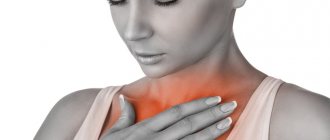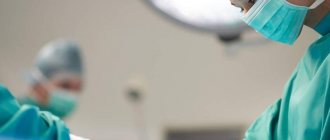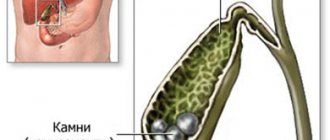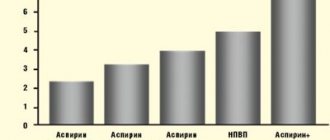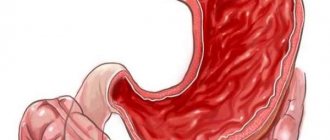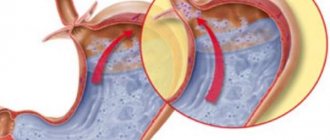Under the influence of aggressive hydrochloric acid and enzymes found in the contents of the stomach and duodenum, inflammation occurs in the mucous membrane of a distant part of the esophagus, and erosions are likely to occur, leading to disruption of the passage of food.
The main diagnostic criterion for gastroesophageal disease is heartburn or acid regurgitation. It is believed that the presence of heartburn 1 or more times per week over the past 12 months is a clinical criterion for the diagnosis of GERD.
Causes of gastroesophageal disease
Single reflux of stomach contents into the esophagus can occur in almost all people. The disease is indicated when reflux becomes frequent and prolonged, accompanied by clinical symptoms and or damage to the esophageal mucosa. A number of factors play a role in the development of the disease.
The main role is played by dysfunction of the lower esophageal sphincter due to a decrease in its tone. Another reason may be an anatomical change in the esophagogastric junction that occurs when a hiatal hernia occurs. The occurrence of reflux is also facilitated by overfilling the stomach with food and impaired gastric motility. In addition, the following conditions may contribute to the development of this disease:
- diseases of the stomach and duodenum, such as chronic gastroduodenitis, peptic ulcers, gastro- and duodenostasis, which slow down gastric emptying and the movement of food masses into the intestines;
- disorders of autonomic nervous regulation;
- violation of the regime and quality of nutrition, overeating, abuse of fatty foods;
- excess body weight;
- taking certain medications;
- food allergies;
- smoking, excessive alcohol consumption;
- the presence of foci of chronic infection;
- stress;
- excessive physical activity;
- constipation;
- prolonged stay in an inclined position;
- pregnancy;
Examinations include:
- 24-hour pH-metry of the esophagus. During the examination, pathological acid or alkaline (bile) reflux from the stomach and duodenum into the esophagus is revealed. Their duration is also set.
- Esophageal manometry. Peristalsis of the esophagus, intraesophageal pressure of the upper and lower esophageal sphincters and motility of the thoracic esophagus are studied. In the absence of contraction of the thoracic esophagus, surgical treatment is contraindicated, because suggests the occurrence of postoperative complications in the form of dysphagia.
The goal of antireflux surgery is to mechanically restore the anatomical integrity and function of the esophagogastric junction (cardia). The operation, its volume, and the avoidance of postoperative complications depend only on the surgeon.
It should be noted that not all patients achieve a positive effect with surgical treatment. A multicenter study showed that when taking the antisecretory drug Nexium, remission of GERD was observed in 92%, and with surgical treatment - in 85%.
According to various authors, the effectiveness of the operation is observed in 90% of patients within 3 years, and in 67% after 7 years. After surgery you may experience:
- impaired gastric emptying,
- bloating due to damage to the vagus nerve during surgery,
- dysphagia,
- Some patients experience heartburn and belching.
Antireflux surgery may improve the patient's condition. Can improve quality of life. But changes in lifestyle and nutrition, dosed physical activity, the use of modern medications and endoscopic treatment methods significantly reduce the need for surgical treatment of these patients and make convincing long-term control over GERD.
Forms of gastroesophageal reflux disease (GERD)
According to modern concepts, there are three forms of the disease:
- endoscopically negative reflux disease, manifested by heartburn without erosive changes in the esophageal mucosa.
- endscopically positive (erosive) reflux disease with a progressive course and possible development of complications in the form of ulcers, bleeding, strictures.
- Barrett's esophagus is a condition in which irreversible changes occur in the lining of the esophagus, with a high risk of further malignant degeneration.
Surgical treatment of gastroesophageal reflux disease (heartburn, reflux esophagitis)
What is gastroesophageal reflux disease?
True (primary) gastroesophageal reflux disease (GERD) is a consequence of dysfunction of the lower sphincter of the esophagus and is manifested by gaping (opening) of the cardia (esophageal-gastric junction) during endoscopy of the esophagus or its contrast radiography, which reveals signs of reflux esophagitis of varying severity .
Clinical manifestations of GERD include heartburn, belching, regurgitation of food, chest pain when swallowing, difficulty passing food into the stomach, possible pain in the abdomen and chest, as well as extra-esophageal manifestations - night cough, hoarseness, episodes of suffocation, etc.
Secondary (symptomatic) GERD occurs against the background of other diseases of the abdominal organs (diaphragmatic hernia, duodenal ulcer, chronic pancreatitis, duodenostasis, achalasia cardia, etc.) or systemic diseases (scleroderma and other diffuse connective tissue diseases, eosinophilic esophagitis ). Late complications of long-term GERD are the development of peptic ulcers and strictures (scar narrowing) in the lower third of the esophagus, shortening of the esophagus, which often occurs in old age and requires complex surgical treatment. Another common complication of GERD is Barrett's metaplasia—replacement of the esophageal mucosa above the cardia with intestinal epithelium, which is often accompanied by epithelial dysplasia and increases the risk of developing esophageal adenocarcinoma.
Why is it better to perform surgery at the Grand Medica clinic?
The task of specialists (gastroenterologist, surgeon) of a medical clinical center is to establish the true cause of GERD and determine the optimal method of treatment (conservative therapy with an assessment of the clinical situation over time, or surgical treatment - the type of antireflux operation and the prognosis of its result depending on the existing symptoms). Performing laparoscopic fundoplication in a medical clinical center guarantees the correct determination of indications for this treatment method, careful adherence to the intervention technique, which is the key to its effectiveness and good long-term results.
Who needs surgical treatment for gastroesophageal reflux disease?
Indications for antireflux surgery for GERD can include both true GERD and secondary gastroesophageal reflux (acid or alkaline). Surgical treatment is indicated for true GERD complicated by Barrett's metaplasia, esophageal stricture, shortening of the esophagus, esophageal bleeding, and side effects from therapy with acid-lowering drugs. In patients with extra-esophageal manifestations, it is necessary to determine the acidity in the esophagus - probe pH-metry of the esophagus to identify the connection of symptoms with reflux.
Laparoscopic fundoplication
in our center it is performed using the “gold standard” methods or in the form of full or partial fundoplication (short-floppy Nissen, Toupet). A properly formed fundoplication cuff protects the esophagus from acid or alkaline (bile) reflux around the clock, in contrast to drug treatment.
In patients with morbid obesity and severe manifestations of GERD, the Grand Medica clinic uses laparoscopic gastric bypass, which, along with persistent correction of body weight, allows the patient to be relieved of gastroesophageal reflux.
Laparoscopic fundoplication, as a rule, is easily tolerated by the patient, eliminates existing symptoms, relieves the patient of the need for constant drug therapy, improves quality of life, prevents the progression of changes in the esophagus and the development of complications of reflux esophagitis. The results of surgical treatment of reflux esophagitis and GERD are assessed using fluoroscopy and esophagogastroscopy no earlier than 6 months later. The frequency of relapse (return) of symptoms many years after laparoscopic fundoplication does not exceed 13-15% of all operated patients, the need for repeated fundoplication (if side effects of surgery develop) is no more than 3-5%.
Clinical symptoms of GERD
Clinical symptoms of GERD are divided into esophageal and extraesophageal.
Esophageal symptoms
Heartburn “a burning sensation ascending from the stomach or lower chest to the neck.” With severe heartburn, this feeling may spread to the lateral chest and neck area, reaching the lower jaw. Heartburn may be accompanied by a feeling of “a warm wave rolling up to the throat” associated with the reflux of gastric contents. Heartburn may appear or worsen when bending forward, straining, lying down, or after eating. Standing, swallowing saliva, drinking a few sips of water, or taking antacids may reduce its intensity.
Regurgitation (or regurgitation) is the passive movement of stomach contents into the esophagus and then into the oral cavity. Often accompanied by a feeling of acidity or bitter taste in the mouth. It is provoked or aggravated by a horizontal position of the body, tilting the body, or an increase in intra-abdominal pressure. Regurgitation can lead to the reflux of contents into the pulmonary tract (aspiration) and lead to the development of laryngitis, cough, asthma and pneumonia. Belching is one of the variants of regurgitation. The main component is not gastric contents, but air. It can also be bitter or sour. Dysphagia, a feeling of food being “stuck” when swallowing and passing through the esophagus. At the initial stages of the disease, dysphagia occurs due to impaired motor function of the esophagus and is intermittent. In advanced cases with esophageal stricture, dysphagia becomes persistent.
Signs of the disease also include pain and discomfort in the epigastric region, pain in the chest, behind the sternum.
Extraesophageal manifestations of GERD
Symptoms of diseases of neighboring organs that can be caused by reflux:
- Cardiac symptoms (pain in the left half of the chest, heart rate abnormalities) can be triggered by reflux, hypermotility of the esophagus. Unlike angina, these pains have several features: they have a burning tint, have a retrosternal localization without irradiation, are caused by food intake, appear when changing body position and subside after taking drugs that reduce acidity.
- Pulmonary manifestations (cough, asthma attacks) are associated with vagal irritation and the appearance of bronchospasm or with the entry of stomach contents into the bronchi during regurgitation and the development of chronic bronchitis, repeated pneumonia, bronchial asthma and fibrosis of the lung tissue.
- ENT manifestations (hoarseness and loss of voice, dysphonia, sore throat, neck, hypersalivation) are associated with inflammation of the posterior wall of the larynx, pharynx, and the development of chronic laryngitis and pharyngitis.
- Dental manifestations (burning tongue, cheeks, impaired taste, caries) are caused by oxidation of saliva in the oral cavity, damage to the mucous membrane and demineralization of tooth enamel.
- Gastric (rapid saturation, fullness, distension of the stomach, nausea, bloating, flatulence.
Variants of the course of reflux disease
The classic version of the disease is manifested by a combination of heartburn, the frequency and intensity of which coincides with the intensity of inflammation and regurgitation. More often, exacerbations occur 1-2 times a year, but a rarely recurrent variant of the course of the disease with exacerbations once every 2-3 years can also occur.
Complications of GERD include the erosive-ulcerative variant of the disease, because it causes bleeding and perforation of the esophagus. Narrowing of the esophagus is also a serious complication of GERD.
Features of GERD in young people
In young people (under 30 years of age), the clinical picture is dominated by pain and dysphagia. Moreover, the development of the disease is often combined with dysfunction of the autonomic nervous system.
Features of GERD in older people
In older people, on the contrary, an asymptomatic or low-symptomatic course of the disease often occurs. Among the complaints, heartburn predominates, which, as the disease progresses, is joined by pain when food passes through the esophagus. Sometimes such chest pain resembles pain due to coronary heart disease.
Features of GERD in obese people
For most people with increased body weight, complaints of dysphagia come to the fore; only a third have chest pain and less than a quarter experience heartburn. This is due to the fact that against the background of obesity, the motor-evacuation function of the stomach is disrupted and gastric secretion decreases.
Features of GERD in obese people
GERD and bronchial asthma have a pronounced mutually aggravating effect. Irritation of the esophageal mucosa by acidic gastric contents causes bronchospasm, and microaspiration of hydrochloric acid into the respiratory tract can further worsen the situation. The presence of bronchial asthma, in turn, leads to a decrease in the tone of the esophagus and a more frequent occurrence of regurgitation and heartburn. Therefore, such mutual aggravating influence requires more intensive treatment of both diseases.
Features of GERD in obese people
The identification of this combination of diseases as a separate variant is due to the fact that there is drug interaction between gastric secretion blockers and antiplatelet/anticoagulant drugs. As a result of this interaction, the drug effect may be reduced, which immediately worsens the course of coronary artery disease.
Complications of GERD
The most common complication is erosive and ulcerative damage to the esophagus. In turn, the course of esophageal ulcers can be complicated by the development of bleeding, perforation of the ulcer, or the formation of a stricture (scar narrowing) of the esophagus.
In addition, the healing process of esophageal ulcers can occur by replacing the damaged area with intestinal-type epithelium, the so-called. “intestinal neoplasia”, i.e. lead to Barrett's esophagus. Barrett's esophagus is a disease in which a change in the structure of the epithelium of the esophagus occurs, and it is replaced by cells that are not typical for the mucous membrane of this section. There are several options for such replacement: transitional epithelium, gastric epithelium and intestinal epithelium. It is the latter option that is unfavorable from a prognostic point of view, since replacement with intestinal-type epithelium (“intestinal metaplasia”) is a risk factor for the development of esophageal cancer.
Diagnostics
In order to diagnose EC, an endoscopy is usually performed, on which the erosive surface of the lower third of the esophagus, often covered with ulcers, becomes visible; esophagomanometry is performed, which indicates a decrease in propulsive motility and tone of the lower esophageal sphincter, but we consider the main study to be radiography of the esophagus with barium, which makes it possible to register only reflux of contrast into the esophagus, but see reflux into the flesh up to the respiratory tract, identify the hiatal hernia that often accompanies this disease, assess the tone of the esophagus, and see the propulsive motility of the esophagus, and identify whether there are scar structures of the esophagus. Often, long-term existing heartburn may at some point be replaced by sensations of dysphagia, when the patient feels that food is stuck behind the sternum. This is a sign of the formation of a cicatricial narrowing of the esophagus. A frequent complication of such ER indicates extraesophageal manifestations of treatment-resistant cardiac arrhythmias, which are associated with irritation of the heart adjacent to the esophagus.
Diagnosis of gastroesophageal reflux disease
The main diagnosis of GERD is based on characteristic complaints that bother the patient. Additional examination methods are necessary to determine the stage of the disease, identify its complications and plan treatment.
Endoscopic examination of gastroesophageal disease
FGDS is the main method for confirming the presence of esophagitis, identifying or excluding hiatal hernia, combined lesions of the stomach and duodenum. A biopsy from the esophagus can confirm the presence of Barrett's esophagus and assess the risk of developing a malignant tumor.
3. Diagnosis of GERD
To diagnose GERD
The doctor will conduct a general examination and ask several questions about the symptoms of the problem. Depending on your health, further tests may be needed, or your doctor may simply recommend medications that will reduce stomach acid production. These may include H2 blockers and proton pump inhibitors (for example, omeprazole). If your heartburn goes away after you take the medicine, your doctor will likely diagnose GERD. For mild symptoms of GERD, you can also try medications from the antacid group. In addition, changing your diet, losing weight (if you are overweight) and some other lifestyle changes can help. If all these measures do not help, consult a doctor - more serious treatment may be required.
About our clinic Chistye Prudy metro station Medintercom page!
Treatment of gastroesophageal reflux disease
Surgical and conservative treatment of gastroesophageal disease is possible based on the type of pathological transformations in the esophagus. Conservative treatment is aimed at eliminating the manifestations of the disease, preventing the reflux of stomach contents into the esophagus, treating inflammation and includes the use of medications and diet.
One of the important conditions for successful treatment is nutritional correction and lifestyle changes. In this case, both the nature of the food and its volume, and diet are important:
- It is necessary to avoid foods that irritate the esophagus or increase the formation of gas.
- It is necessary to adjust the amount of food, avoid eating before bed or at night.
- Quitting smoking, reducing body weight, and avoiding tight clothing, belts, and corsets that increase intra-abdominal pressure are very important.
4. Treatment of GERD and indications for surgery
In particularly serious cases, when medications do not help treat gastroesophageal reflux disease or you cannot take them due to side effects, surgery may be recommended to treat GERD.
The surgery, called
a fundoplication
, helps strengthen the valve between the esophagus and the stomach. But many people, even after surgery, need to take some kind of medication, albeit not so serious.
To treat GERD, you may need to take medications for many years to control the symptoms of the disease. There's nothing wrong with that. also make some lifestyle changes to help relieve the symptoms of GERD.
Here's what you can try:
- Change your eating habits. Diet for GERD is very important. It is better to eat little and often than two or three times a day, but in large portions. After eating, wait 2-3 hours before going to bed. Snacking at night is also not the best option. Chocolate, mint and alcohol can worsen GERD by relaxing the valve between the esophagus and stomach. Spicy foods and foods that contain a lot of acid (such as tomatoes and oranges), as well as coffee, can make GERD symptoms worse. In general, observe - you may notice that some foods make you feel worse. Then you should refuse them.
- Do not smoke.
- If heartburn occurs at night, raise the top of the bed by about 15 centimeters (you can use some blocks or stands under the legs of the bed for this). An extra pillow will not cope with this task!
- Avoid wearing clothes that are too tight (around the waist).
- If you are overweight, you need to lose weight. This really helps.
